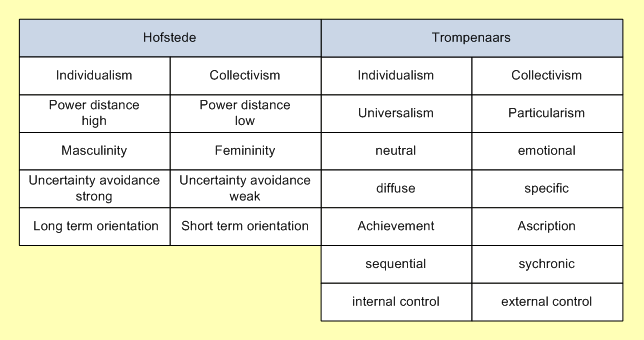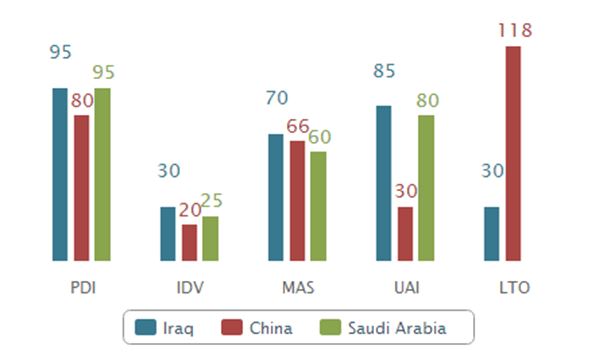MBA Management Cross Cultural Training
Cross Cultural Training. This MBA paper discusses Cross Cultural Training and its objectives, Importance of intercultural training in globalization, Key intercultural skills for expatriate training, Types and benefits of intercultural training and determinants of cultural difference.
Introduction
Inter cultural training is fast becoming a clearly important element in the world of global industry (Zakaria, 2000) This assignment discusses Cross cultural training and its objectives, Importance of intercultural training in globalization, Key intercultural skills for expatriate training, Types and benefits of intercultural training, Determinants of cultural differences, Differences across cultures in people and practices, Socio-Cultural aspects of expatriate adjustment and Intercultural training issues.
Intercultural Training
Inter cultural training means “Any intervention aimed at increasing an individual’s capability to cope with and work in foreign environment” (Tung, 1981). It includes one to one discussion and imitation of the situations of other culture to understand the culture of host country. In other way cross cultural training means “Formal methods to prepare people for more effective interpersonal relations and job success when they interact extensively with individuals from cultures other than their own” (Brislin and Yoshida, 1994). Definition of cross cultural training hence is wide to include differences in areas like linguistic skills, corporate manners, views and principles, social system, negotiating styles etc. of any culture. The benefits of inter–cultural training are (Zakaria, 2000);
- A distinct advantage for organizations
- By continuous changing home country mode to a socially adjustable and suitable culture
- By improving how to cope up with unpredicted events and by dealing with cultural shock in host country culture
- By decreasing uncertainty in expatriates while dealing with host country citizens
- Increasing expatriates managing skills by reducing stress and disorientation (Zakaria, 2000) So this is the instrument for increasing the corporate culture and follows constantly reviewing the activity of expatriates in the companies
Importance of Intercultural Training in Globalisation
Changing Nature of International Organisations
Because of increasing co enterprise and unions and the huge developments in minor to major businesses as significant contributions in globalisation. Due to shift in financial circumstances changed the way of organisations looking at the value efficiency of expatriates (Harris and Kumra, 2000)
Change in Host Location
Due to huge foreign direct investment in foreign countries and inter cultural improvements the demand of expatriate assignment rise between established countries with a drop in the percentage of managers moving from developed world to the Third World (Harris and Kumra, 2000)
Key Intercultural Skills for Expatriate Training
According to Hofstede (1980, p. 398) important intercultural skills are as follows:
- The ability to interconnect esteem
- The ability to be broadminded
- The ability to accept others ideas and views
- The ability to show sympathy
- The ability to be elastic
- The ability for giving chance to others in debates
- Patience for doubtfulness
Gudykunst and Hammer (1983) focused on types of cross cultural training approaches. According to them there are two approaches:
Experiential versus Didactic: This method is based on an observation that individuals, mainly grownups, study by performing the task. (Knowles, 1972, 1975, 1990; Tough, 1979) For effectiveness in this approach learner have to study the processes and tactics for their significance in their society; improve a positive approach to the concept which will bring positive outcomes for them and also for another (Richards, 1997). In the didactic (information giving) approach, based on the thoughts that a cognitive understanding is essential before people can interact with another culture. This can be done by information giving such as lectures, videos and group discussions.
Culture Specific versus Culture General: Culture specific training gives information and direction about culture where expatiate is moving soon for his assignment. Culture specific method includes methods like culture specific briefings, assimilation and readings, giving expatriate knowledge about the country (e.g. past and present situation, creed); important ethics, or what to do and what not to do in that particular culture. (Harris and Kumra, 2000)On the other hand, Culture general training is about providing information to the peoples which they can use in any new culture with anew variety of know hows and developing expatiates with a set of expertise of how to deal with unknown cultures. Types of approach used in this include simulations and self-assessments (Harris and Kumra, 2000)
Types and Benefits of Intercultural Training
Pre Departure Training: This is the traditional form for intercultural training and it is conducted in the home country and organised about a month ago before departure. For better efficiency, the training should be given when the trainees are most motivated to learn (Selmer, 2009) For example, if a person is unable to concern learning about another culture may not benefit from pre-departure training. The duration of most Cross Cultural Training programmes is depends upon the cultural distance from home country to host country. For example between the West and China (Branine, 2005). This experience is called ‘‘tourist phase’’ (Torbiorn,1982)
Post Arrival Training: Post arrival training is further beneficial when provided after expatriate coming back from host country to home country. (Gudykunst et al., 1996; Selmer et al., 1998). This takes around three to six months to start and focused on developments in the host country culture, world view, mentality, values, living patterns and social structure (Torbiorn, 1994). This training can take place at the host country, the home country or any other place. This is like ‘‘on site’’ training of expatriates. ‘‘on site’’ training supports to study innovative administrative measures, and help them adjust to the new cultural background.
Sequential Training: This training must be progressing in steps starting at pre departure and continuing to the post arrival phases which provides a complete direction for expatriate’s step by step improvement towards knowing the value and beliefs of the host culture. (Selmer, 2009) Sequential training has three pre conditions. First, expatriate’s encounters a much diverse societal atmosphere, that the expatriate has faced situations which were unknown before without any option. Then, the relocation to the overseas nation is within a short period of time. Third, expatriate Stays in the host culture for long time for situation to be restructured and the new behaviors to be taught (Selmer et al., 1998).
Content and Duration of Cross Cultural Training
Brislin (1979) has identified three different contents of Cross cultural Training as being cognitive, effective and behavioral in nature. The cognitive content matches to a distribution of information through discussions and other non-participatory resources. Cognitive content contain facts and figures important for real world measures, for example geographic knowledge, weather, accommodation, universities etc. The effective content aims at aggravating individual responses to learn how to deal with critical cultural situations.

The behavioral content aims at improving the communication style of participants for decent relationships with members of host culture and could enables communication with natives, shows an ability to show the interest to learn about overseas culture, supports expatriate to be well mannered (Eschback et al., 2001; Selmer, 2006). Duration of Cross Culture Training sessions are depending upon what training expatriate is getting ranging from one day or designed for few days or a month (Caligiuri et al., 2001; Gudykunst et al.). For example, language training from basic level to advance level reneging from one day to one month.
Benefits of Cross Cultural Training
Cross cultural training improves consciousness amongst people in order to promote clear lines of communication and better relationships. Cross Cultural Training should enable expatriates to determine appropriate cultural behaviours in the host country and suitable ways to perform their job tasks (Black and Mendenhall, 1990). Through Cross Cultural Training, expatriates may get familiar with unexpected happenings in the new cultural background and to reduce conflict due to unexpected actions and situations. Furthermore, it also shows that in the pre departure Cross Cultural Training, the training may help expatriates to create accurate outlooks with respect to living and working in the host country. (Black and Mendenhall, 1990; Black et al., 1991)
An Integrated Cross Cultural Training Model
This model relates the success of training to the development of acculturation. This supports expatriates to act very effectively and reduce stressful practices while facing the insecurity in overseas nations. This model defines acculturation as both a development and a state. For individual persons, family support and willingness to acculturate features added. The type of job assignment, length of assignment and type of training added in situational features. The main improvement in this model is the adding of extra critical process earlier cultural contact takes place, both of which are antecedents to the acculturation process. (Zakaria, 2000)
The new procedure is the moderating process which needs good training programs. The main purposes of this procedure are: adjust the individual and situational characteristics; decrease the culture shock like stress, disorientation, learning and skills deficits; accomplish improved acculturation results. Cross cultural training is important element. With the help of integrated cross cultural training program organisations gain benefits if training is provided in a proper way (Nixon & Dawson 2013)
Determinants of Cultural Differences
Pioneering study of cultures across modern nations done by Hofstede, Dutch social psychologist, in different cultures evaluated the outcomes and establishes forms of likeness and variance among the answers along these five dimensions. According to Hofstede (1981, in Hofstede, 2001) there are some magnitudes in to the cultural factors. These factors are as follows:
- Power distance index (PDI): This state to the degree of dissimilarity that exists – and is accepted – between persons with and without power. A high PD score shows that culture agrees an unequal circulation of power and people recognise “their place” in the system. A Low PD shows that power is shared and well distributed. It also means equality in the society members.
- Individualism (IDV): means specific point at which persons take care about them beyond family and with a very few close friends or stay incorporated into groups usually around the family.
- Masculinity (MAS) vs. feminism: means the circulation of emotional roles amongst the sexes. It opposes a tough masculine to tender feminine society. The assertive pole has been called ‘masculine’ and the modest and the caring pole called ‘feminine’.
- Uncertainty avoidance index (UAI): this deals with a culture’s open mindedness for uncertainty and ambiguity; which shows the states to man’s hunt for reality. It shows to what level a culture programs its members to feel in unstructured conditions. For example, uncomfortable or comfortable.
- Long term orientation (LTO): This state that at what dimensions values and ethics age old works as opposite to short term customs and beliefs. Countries those are having a high Long term orientation score, bringing on social responsibilities and side stepping “loss of face” are count very significant.
Differences across Cultures in People and Practices
Many people behave significantly different in different situations because of their cultures differences. The motivational desires of the expatriates and executives differ from culture to culture. The driving force which causes peoples to do the job in India may not be the same for Chines peoples; international manager must understand the modifications in the people’s mode of doing work. (Neelankavil and James, 2012)
The manufacture services of organizations may be same through divisions but the mind-set of the people’s changes organizations to organizations. For example, Japanese management system like quality circles failed when they have applied into Indian organisations. Neelankavil, Mathur and Zhang (2012) study shows that in four countries for management development and motivational aspects in both different training found diverse management values, value dimensions and relative administration. India established a similar value to America than its neighbor country china though less geographic distance. For example, Drive and ambition were significant for American managers (91) for achievement which is not the instance for China (7) (Neelankavil, Mathur and Zhang, 2012)
Socio Cultural Aspects of Expatriate Adjustment
There is difference in Socio-Cultural and psychological adjustments in the concept of inter cultural adjustment (Searle and Ward, 1990; Ward and Kennedy, 1992, 1993; Ward and Searle, 1991). Socio-Cultural adjustment communicates the capability to successfully interact with the peoples of overseas country (Ward and Kennedy, 1996) which has been linked with objects that encourage and enable to learn other countries culture and acquire social skills. (Cross, 1995; Searle and Ward, 1990) The Socio-Cultural stressed on social behavior (Black and Mendenhall, 1991; Furnham, 1993; Klineberg, 1982).Psychological adjustment means person’s happiness in their new social backgrounds linked with persons emotions, cognitive views, and individual features (Ward and Kennedy, 1996). Black et al. (1991) discussed in their recommended model for international managers modification, difference in three types of modification is as follows:
- Modification towards expatriates work;
- Modification towards communicating with citizens of the host country;
- Modification towards social situation.
Conclusion
It is very important that for sending their expatriates to the host country must be aware of situations in an overseas. Managing with an overseas nation both administrative and national require well organized homework. A very well equipped cross cultural training will help the organizations to be ready for, with the fluctuations in the functioning policies, principles and ethics they are predicted towards the future. There is a degree of variance expatriate may see while moving to a host country. An organisation may face losses due to unorganized cross cultural training and that is the matter of great concern.
For preparing the expatriates for an overseas mission is equally advantageous for the companies and for international managers. In cross cultural training it is very important that which type of training program organisation using. A good organised inter cultural teaching program might help in uncertain circumstances; from this activity industry can get the best possible output from the international managers by taking care of the employee confidence and inspiration. Now from the above arguments we can say that inter cultural training is the main factor for success in international human resource management.
References
Black, J. and Mendenhall, M. (1990) Cross Cultural Training Effectiveness: A Review and a Theoretical Framework for Future Research. Academy of Management Review [Internet], 15(1), January, pp.113 136.
Brislin, R. and Yoshida, T. (1994) Intercultural Communication Training: An Introduction [Internet], Sage publication ltd., London.
Graf, A. (2004) Screening and training inter cultural competencies: evaluating the impact of national culture on inter cultural competencies. International Journal of Human Resource Management.
Graf A, Mertesacker, M. (2009) Intercultural training: six measures assessing training needs. Journal of European Industrial Training.
Harris, H. and Kumra, S. (2000) International manager development—Cross cultural training in highly diverse environments. Journal of Management Development.
Hofstede, G.S. (2001) Culture’s Consequences: Comparing Values, Behaviours, Institutions and Organizations across Nations, 2nd ed., Thousand Oaks: Sage Publications Ltd., United Kingdom.
Interview by Powell, S. (2006) Geert Hofstede: challenges of cultural diversity, Human Resource Management International Digest.
Mathur, A, Zhang, Y, and Neelankavil, J. (2012), Critical managerial motivational factors: A cross cultural analysis of four culturally divergent countries, International Journal of Cross Cultural Management.
Neelankavil, and James P.(2012) ‘Determinants of Managerial Performance: A Cross cultural Comparison of the Perceptions of Middle level Managers in Four Countries’, Journal of International Business Studies.
Nixon, J. and Dawson, G. (2013) Reason for cross cultural communication training, Corporate Communications.
Selmer J. (1999) Culture shock in China? Adjustment pattern of western expatriate business managers. International Business Review.
Selmer, J. (2004) Psychological barriers to adjustment of Western business expatriates in China: Newcomers vs long stayers. The International Journal of Human Resource Management.
Selmer, J. (2005) Cross cultural training and expatriate adjustment in China: Western joint venture managers.
Selmer, J. (2009) Expatriate cross cultural training for China: views and experience of “China Hands”, Management Research Review.
Waxin, M. and Panaccio, A. (2005) Cross cultural training to facilitate expatriate adjustment: it works!
Zakaria, N. (2000) The effects of cross cultural training on the acculturation process of the global workforce. International Journal of Manpower.


